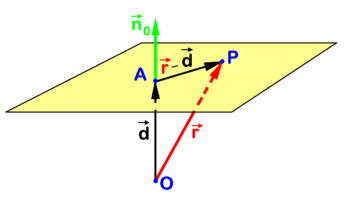User talk:Paul Wormer/scratchbook1: Difference between revisions
Jump to navigation
Jump to search
imported>Paul Wormer No edit summary |
imported>Paul Wormer No edit summary |
||
| Line 1: | Line 1: | ||
''' | {{Image|Param1 plane.png|right|350px|Equation for plane.}} | ||
Analytic geometry knows several closely related algebraic equations for a plane in three-dimensional Euclidean space. One such equation is illustrated in the figure. Point ''X'' is an arbitrary point in the plane and ''O'' (the origin) is outside the plane. The point ''A'' in the plane is chosen such that vector | |||
:<math> | |||
\overrightarrow{OA} \equiv \vec{\mathbf{a}} | |||
</math> | |||
is orthogonal to the plane. The vector | |||
:<math> | |||
\hat{\mathbf{n}} \equiv \frac{\vec{\mathbf{a}}}{a} \quad \hbox{with}\quad a \equiv {|\vec{\mathbf{a}}|} | |||
</math> | |||
is a unit (length 1) vector normal (perpendicular) to the plane. The following relation holds for an arbitrary point in the plane | |||
:<math> | |||
\left(\vec{\mathbf{r}}-\vec{\mathbf{a}}\right)\cdot \hat{\mathbf{n}} = 0 \quad\hbox{with}\quad \overrightarrow{OX} \equiv \vec{\mathbf{r}} . | |||
</math> | |||
Evidently ''a'' is the distance of ''O'' to the plane. | |||
This equation for the plane can be rewritten in terms of coordinates with respect to a Cartesian frame with origin in ''O'', | |||
:<math> | |||
\vec{\mathbf{r}}\cdot \hat{\mathbf{n}} = \vec{\mathbf{a}}\cdot \hat{\mathbf{n}} | |||
\Longrightarrow | |||
x a_x +ya_y+za_z = a | |||
</math> | |||
with | |||
:<math> | |||
\vec{\mathbf{a}} = (a_x,\;a_y,\; a_z), \quad | |||
\vec{\mathbf{r}} = (x,\;y,\; z) | |||
</math> | |||
= | |||
Revision as of 11:20, 29 March 2010
Analytic geometry knows several closely related algebraic equations for a plane in three-dimensional Euclidean space. One such equation is illustrated in the figure. Point X is an arbitrary point in the plane and O (the origin) is outside the plane. The point A in the plane is chosen such that vector
is orthogonal to the plane. The vector
is a unit (length 1) vector normal (perpendicular) to the plane. The following relation holds for an arbitrary point in the plane
Evidently a is the distance of O to the plane.
This equation for the plane can be rewritten in terms of coordinates with respect to a Cartesian frame with origin in O,
with





